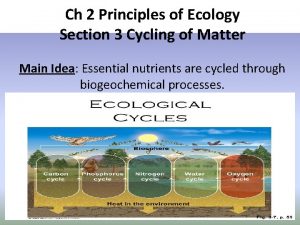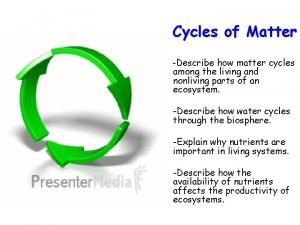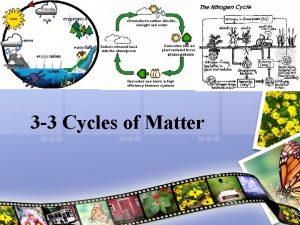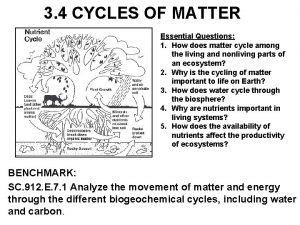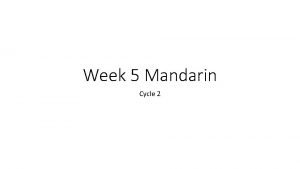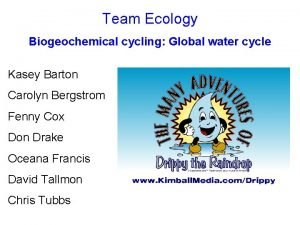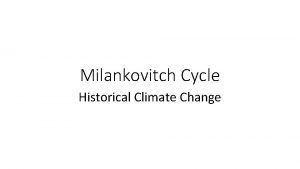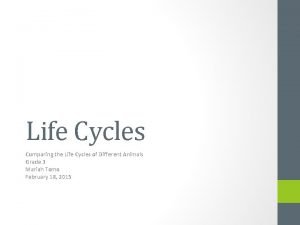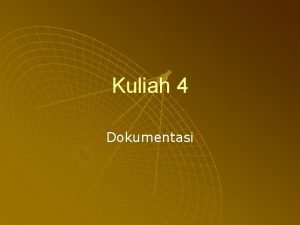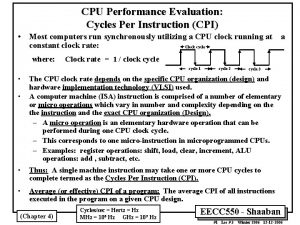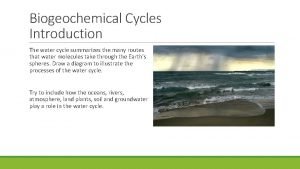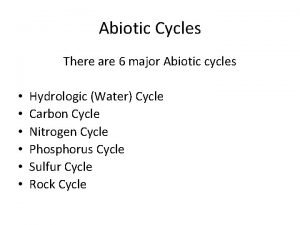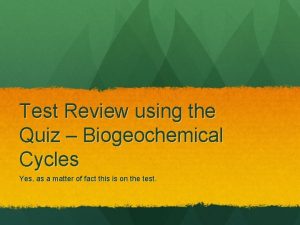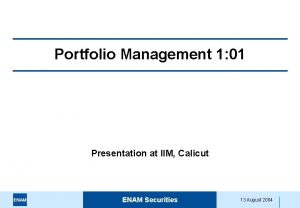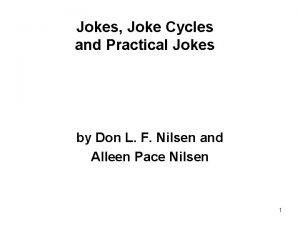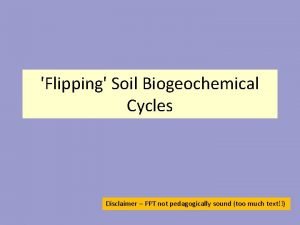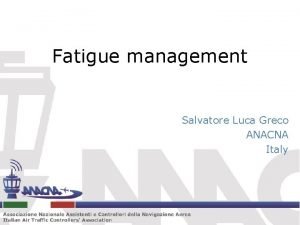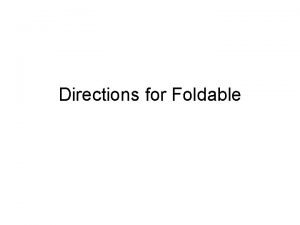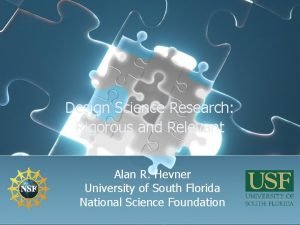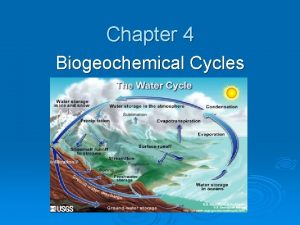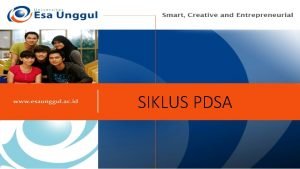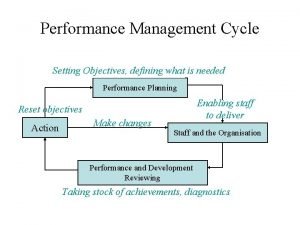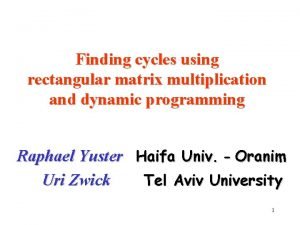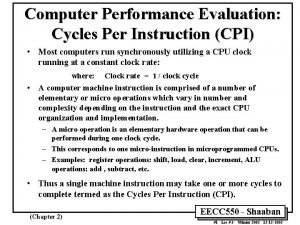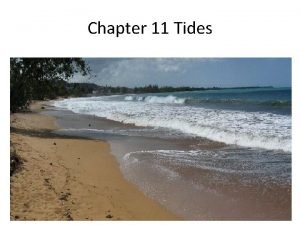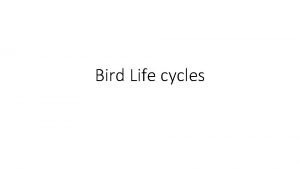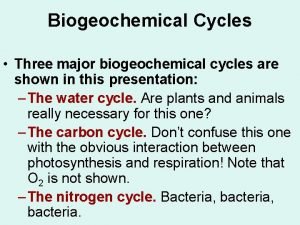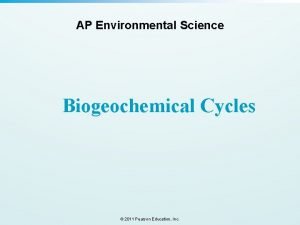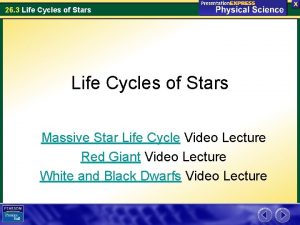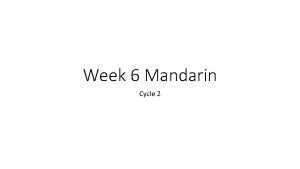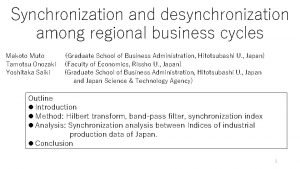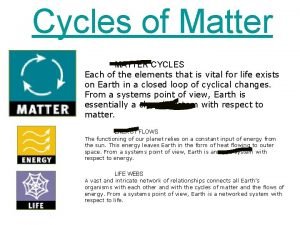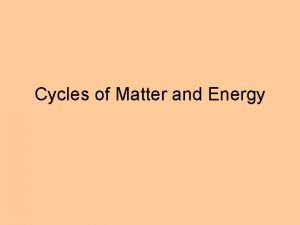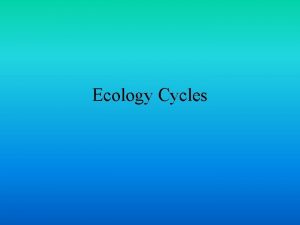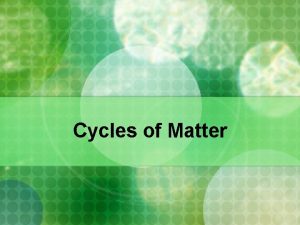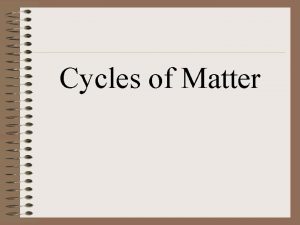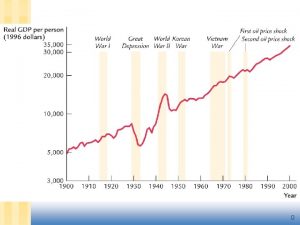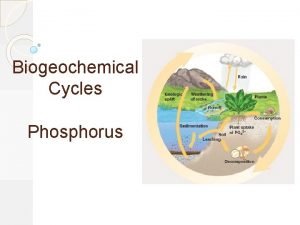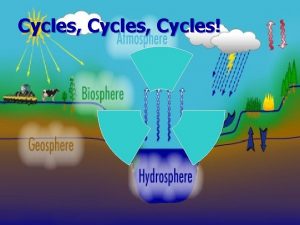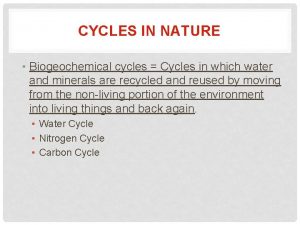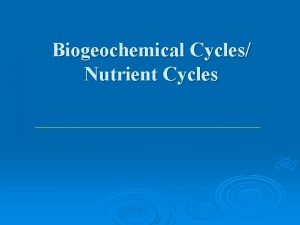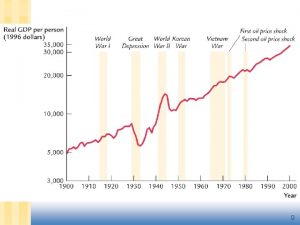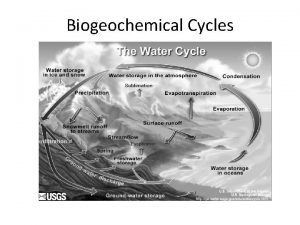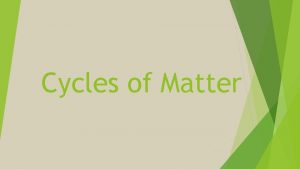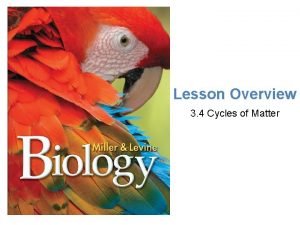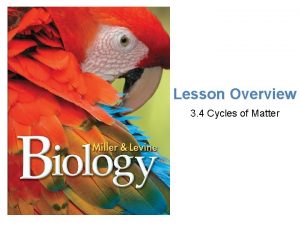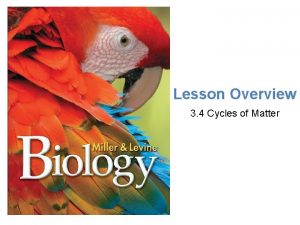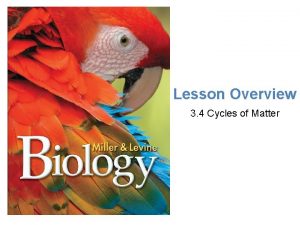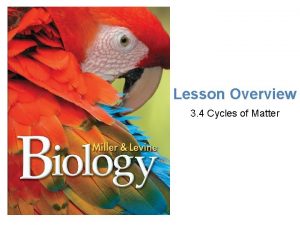Lesson Overview Cycles of Matter Lesson Overview 3
















































- Slides: 48

Lesson Overview Cycles of Matter Lesson Overview 3. 4 Cycles of Matter

Lesson Overview Cycles of Matter THINK ABOUT IT ØA handful of _______ combine to form the building blocks of all known organisms. ØOrganisms cannot manufacture these elements and do not “use them up, ” so where do essential elements come from? ØHow does their availability affect ecosystems?

Lesson Overview Cycles of Matter Recycling in the Biosphere ØHow does matter move through the biosphere? ØUnlike the one-way flow of _______, matter is ______ within and between ecosystems.

Lesson Overview Cycles of Matter Recycling in the Biosphere Ø Unlike the one-way flow of energy, matter is ______ within and between ecosystems. Ø Elements pass from one organism to another and among parts of the biosphere through closed loops called____________, which are powered by the flow of energy.

Lesson Overview Cycles of Matter Recycling in the Biosphere ØBiogeochemical cycles of matter involve _______processes, ______ processes, and _______ processes. ØAs matter moves through these cycles, it is never _____or_____—just____.

Lesson Overview Cycles of Matter Biological Processes Ø________consist of any and all activities performed by living organisms. ØThese processes include Ø_____________________________.

Lesson Overview Cycles of Matter Geological Processes ØGeological processes include: Ø____________ Øformation and breakdown of _____ ØMajor ___________ within and below the surface of the earth.

Lesson Overview Cycles of Matter Chemical and Physical Processes ØChemical and physical processes include: Ø__________________________ Ø_____________

Lesson Overview Cycles of Matter Human Activity ØHuman activities that affect cycles of matter on a global scale include Ømining and burning of ______ Ø__________ for building and farming Ø__________ Ømanufacture and use of _____.

Lesson Overview Cycles of Matter Recycling in the Biosphere Ø__________ of matter pass the same atoms and molecules around again and again.

Lesson Overview Cycles of Matter The Water Cycle Ø Water molecules typically enter the atmosphere as ______when they ______ from the ocean or other bodies of water. Ø Water can also enter the atmosphere by evaporating from the leaves of plants in the process of ______________.

Lesson Overview Cycles of Matter The Water Cycle ØIf the air carrying it cools, water vapor _____ into tiny droplets that form _______. ØWhen the droplets become large enough, they fall to Earth’s surface as _______ in the form of rain, snow, sleet, or hail.

Lesson Overview Cycles of Matter The Water Cycle Ø On land, some precipitation flows along the surface in what scientists call ____, until it enters a _______ or _____ that carries it to an _____ or ____. Ø Precipitation can also be absorbed into the soil, and is then called___________.

Lesson Overview Cycles of Matter The Water Cycle Ø Groundwater can ________ through their roots, or _____ into rivers, streams, lakes, or oceans. Ø Some groundwater penetrates deeply enough into the ground to become part of ___________.

Lesson Overview Cycles of Matter Nutrient Cycles ØEvery organism needs ______to build tissues and carry out life functions. Like water, nutrients ________and the environment through __________. ØThe three pathways, or cycles, that move ________________ through the biosphere are especially critical for life

Lesson Overview Cycles of Matter Nutrient Cycles ØThe chemical substances that an organism needs to sustain life are called ______. ØEvery organism needs nutrients to ______________and __________. ØNutrients ____________and the environment through __________.

Lesson Overview Cycles of Matter Nutrient Cycles Ø _______ participates in parts of the carbon, nitrogen, and phosphorus cycles by combining with these elements and cycling with them through parts of their journeys. Ø ________in the atmosphere is released by one of the most important of all biological activities: _____________. Ø Oxygen is used in ____________ by all multicellular forms of life, and many single-celled organisms as well.

Lesson Overview Cycles of Matter The Carbon Cycle Ø_____ is a major component of all organic compounds, including ____________________.

Lesson Overview Cycles of Matter The Carbon Cycle Ø___________ is continually exchanged through chemical and physical processes between the atmosphere and oceans.

Lesson Overview Cycles of Matter The Carbon Cycle Ø Plants take in carbon dioxide during ______ and use the carbon to build__________. Ø _________ then pass through food webs to consumers.

Lesson Overview Cycles of Matter The Carbon Cycle ØOrganisms release carbon in the form of carbon dioxide gas by ________.

Lesson Overview Cycles of Matter The Carbon Cycle ØWhen organisms die, _______ break down the bodies, releasing _______to the environment.

Lesson Overview Cycles of Matter The Carbon Cycle Ø___________ can turn accumulated carbon into carboncontaining rocks or fossil fuels.

Lesson Overview Cycles of Matter The Carbon Cycle Ø______is released into the atmosphere by ________ or by ________, such as the burning of fossil fuels and the clearing and burning of forests.

Lesson Overview Cycles of Matter The Carbon Cycle Ø Important questions remain about the carbon cycle. Ø How much carbon moves through each pathway? Ø How do ecosystems _______ to changes in atmospheric carbon dioxide concentration?

Lesson Overview Cycles of Matter The Nitrogen Cycle Ø All organisms require _____ to make _______, which are used to build _______ and _______, which combine to form _____ and _______.

Lesson Overview Cycles of Matter The Nitrogen Cycle ØNitrogen gas (N 2) makes up ____ percent of Earth’s atmosphere.

Lesson Overview Cycles of Matter The Nitrogen Cycle ØNitrogen-containing substances such as ______(NH 3), ______ (NO 3), and _______ (NO 2) are found in soil, in the wastes produced by many organisms, and in dead and decaying organic matter.

Lesson Overview Cycles of Matter The Nitrogen Cycle Ø__________exists in several forms in the ocean and other large water bodies.

Lesson Overview Cycles of Matter The Nitrogen Cycle Ø Although nitrogen gas is the most abundant form of nitrogen on Earth, only certain types of ______ that live in the _____ and on the __________ can use this form directly. Ø The bacteria convert nitrogen gas into ammonia, in a process known as ___________.

Lesson Overview Cycles of Matter The Nitrogen Cycle ØOther soil bacteria convert fixed nitrogen into ______and ______ that __________ can use to make proteins and nucleic acids.

Lesson Overview Cycles of Matter The Nitrogen Cycle ØConsumers eat the producers and _______ to make their own nitrogen-containing compounds.

Lesson Overview Cycles of Matter The Nitrogen Cycle Ø_______ release nitrogen from waste and dead organisms as ______________ that producers may take up again.

Lesson Overview Cycles of Matter The Nitrogen Cycle Ø Other soil bacteria obtain energy by converting nitrates into nitrogen gas, which is released into the atmosphere in a process called ________.

Lesson Overview Cycles of Matter The Nitrogen Cycle Ø A small amount of nitrogen gas is converted to usable forms by ______ in a process called __________________.

Lesson Overview Cycles of Matter The Nitrogen Cycle Ø Humans add nitrogen to the biosphere through the manufacture and use of ____. Excess fertilizer is often carried into ______ or ______ by precipitation.

Lesson Overview Cycles of Matter The Phosphorus Cycle Ø_______forms a part of vital molecules such as ____ and ____. ØAlthough phosphorus is of great biological importance, it is __________in the biosphere.

Lesson Overview Cycles of Matter The Phosphorus Cycle ØPhosphorus in the form of ____________ remains mostly on land, in the form of phosphate rock and soil minerals, and in the ocean, as dissolved phosphate and phosphate sediments.

Lesson Overview Cycles of Matter The Phosphorus Cycle ØAs rocks and sediments wear down, ________ is released. ØSome phosphate stays on land cycles between ____________.

Lesson Overview Cycles of Matter The Phosphorus Cycle Ø _____ bind phosphate into _________when they absorb it from soil or water.

Lesson Overview Cycles of Matter The Phosphorus Cycle Ø_______moves through the food web, from producers to consumers, and to the rest of the ecosystem.

Lesson Overview Cycles of Matter The Phosphorus Cycle ØOther phosphate washes into rivers and streams, where it dissolves. This phosphate eventually makes its way to the ocean, where ___________ process and incorporate it into biological compounds.

Lesson Overview Cycles of Matter Nutrient Limitation ØEcologists are often interested in an ecosystem’s_________—the rate at which primary producers create organic material. ØIf an ___________is in short supply, primary productivity will be limited. ØThe nutrient whose supply limits productivity is called the ____________.

Lesson Overview Cycles of Matter Nutrient Limitation in Soil Ø The __________ is typically limited by one or more nutrients that must be taken up by plants through their roots. Ø Most _______ contain large amounts of nitrogen, phosphorus, and potassium, which help plants grow better in poor soil. Carbon is not included in chemical fertilizers because plants acquire ________from the atmosphere. Ø ___________such as calcium, magnesium, sulfur, iron, and manganese are necessary in relatively small amounts, and are sometimes included in specialty fertilizers.

Lesson Overview Cycles of Matter Nutrient Limitation in Soil ØAll nutrient cycles ______ like the gears shown. ØIf any nutrient is in short supply—if any wheel “sticks”—the whole system slows down or stops altogether.

Lesson Overview Cycles of Matter Nutrient Limitation in Aquatic Ecosystems Ø _______ are nutrient-poor compared to many land areas. Ø In the ocean and other saltwater environments, ________ is often the limiting nutrient. Ø In streams, lakes, and freshwater environments, ________ is typically the limiting nutrient.

Lesson Overview Cycles of Matter Nutrient Limitation in Aquatic Ecosystems Ø Sometimes an aquatic ecosystem receives a ___________ of a limiting nutrient—for example, runoff from heavily fertilized fields.

Lesson Overview Cycles of Matter Nutrient Limitation in Aquatic Ecosystems Ø The result of this runoff can be an ______ —a dramatic increase in the amount of algae and other primary producers due to the increase in nutrients. Ø If there are not enough consumers to eat the algae, an algal bloom can cover the water’s surface and _______ the functioning of an ecosystem.
 Lesson 2 cycles of matter answer key
Lesson 2 cycles of matter answer key Water cycles of matter
Water cycles of matter 3-3 cycles of matter
3-3 cycles of matter Matter cycle
Matter cycle What is classification of matter
What is classification of matter Section 1 composition of matter
Section 1 composition of matter Gray and white matter
Gray and white matter Section 1 composition of matter
Section 1 composition of matter Chapter 2 section 1 classifying matter answers
Chapter 2 section 1 classifying matter answers Gyrus and sulcus function
Gyrus and sulcus function Section 1 composition of matter chapter 15 answer key
Section 1 composition of matter chapter 15 answer key Gray matter and white matter
Gray matter and white matter Ncl caudatus
Ncl caudatus Flow energy review
Flow energy review Mandarin cycles
Mandarin cycles Alliteration words for cycle
Alliteration words for cycle Biogeochemical cycles of water
Biogeochemical cycles of water Model for improvement
Model for improvement Precession milankovitch cycles
Precession milankovitch cycles Correct order
Correct order Relationship between transaction cycles
Relationship between transaction cycles Cpi cycles per instruction
Cpi cycles per instruction Biogeochemical cycles performance task
Biogeochemical cycles performance task Biogeochemical cycles apes
Biogeochemical cycles apes Abiotic cycles
Abiotic cycles Biogeochemical cycles quiz
Biogeochemical cycles quiz Cycles in nature
Cycles in nature Joke cycles
Joke cycles Joke cycles
Joke cycles Biogeochemical cycles class 9 ppt
Biogeochemical cycles class 9 ppt Sleep wake cycle
Sleep wake cycle Cell cycle foldable project
Cell cycle foldable project Design science research cycles
Design science research cycles Compare and contrast carbon and nitrogen cycles
Compare and contrast carbon and nitrogen cycles Biogeochemical cycles poster
Biogeochemical cycles poster Adopsi dalam pdca
Adopsi dalam pdca Cycles perfecta meaning
Cycles perfecta meaning Performance management cycles
Performance management cycles Isagenix cycles chart
Isagenix cycles chart Multiplication of cycles
Multiplication of cycles Cpi in cpu
Cpi in cpu Diurnal tide cycles occur ______.
Diurnal tide cycles occur ______. Life cycle of a bird
Life cycle of a bird 4 major biogeochemical cycles
4 major biogeochemical cycles Pearson
Pearson Section 26.3 life cycles of stars
Section 26.3 life cycles of stars Mandarin cycles
Mandarin cycles Cycle
Cycle Business cycles economics
Business cycles economics
